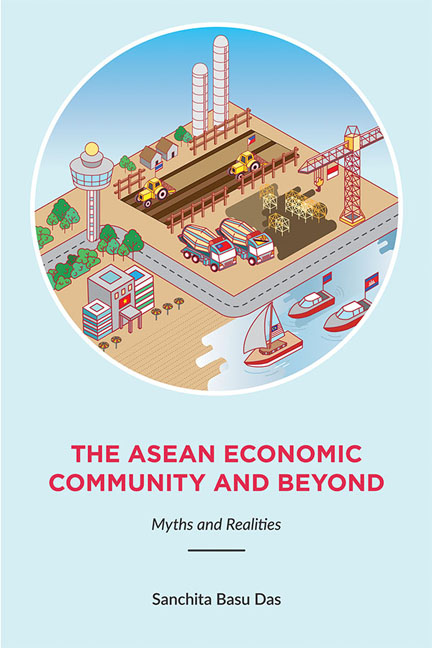Book contents
- Frontmatter
- Dedication
- Contents
- Foreword
- Acknowledgements
- Abbreviations
- 1 Introduction: The ASEAN Economic Community and Beyond
- I THE ASEAN ECONOMIC COMMUNITY (AEC)
- II BEYOND THE ASEAN ECONOMIC COMMUNITY
- III AN ASEAN PERSPECTIVE OF REGIONAL CONNECTIVITY
- 18 Promoting Asia's Infrastructure for Regional Trade and Investment
- 19 Addressing Infrastructure Financing in Asia
- 20 APEC and ASEAN Connectivity: Areas of Mutual Interest and Prospects of Cooperation
- 21 China's Three-pronged Strategy on Regional Connectivity
- 22 Can the China-led AIIB Support the ASEAN Connectivity Master Plan?
- Appendix: Summary of the Trans-pacific Partnership Agreement
- Index
- About the Author
19 - Addressing Infrastructure Financing in Asia
from III - AN ASEAN PERSPECTIVE OF REGIONAL CONNECTIVITY
Published online by Cambridge University Press: 19 May 2017
- Frontmatter
- Dedication
- Contents
- Foreword
- Acknowledgements
- Abbreviations
- 1 Introduction: The ASEAN Economic Community and Beyond
- I THE ASEAN ECONOMIC COMMUNITY (AEC)
- II BEYOND THE ASEAN ECONOMIC COMMUNITY
- III AN ASEAN PERSPECTIVE OF REGIONAL CONNECTIVITY
- 18 Promoting Asia's Infrastructure for Regional Trade and Investment
- 19 Addressing Infrastructure Financing in Asia
- 20 APEC and ASEAN Connectivity: Areas of Mutual Interest and Prospects of Cooperation
- 21 China's Three-pronged Strategy on Regional Connectivity
- 22 Can the China-led AIIB Support the ASEAN Connectivity Master Plan?
- Appendix: Summary of the Trans-pacific Partnership Agreement
- Index
- About the Author
Summary
Between 2010 to 2020, Asia needs to invest a total of around US$8 trillion in overall national infrastructure and an additional US$287 billion in specific regional infrastructure projects. Financing such national and cross-border infrastructure projects for economic integration in the Asia-Pacific region is challenging and complicated. In general, there are several sources of infrastructure finance — Government Budget, Multilateral Development Banks, Commercial Bank Credit, Capital Markets, Sovereign Wealth Funds and Public-Private-Partnership. But each of these has its own features and certain limitations. While national government budgets will continue to be the mainstay for financing infrastructure, it will need to be supplemented by Multilateral Development Banks in the future. Asian governments must put their collective work to mobilize their large pool of savings for regional infrastructure investments. Strengthening national and regional bond markets — through vehicles like the Asian Bond Market Initiative and the Asian Bond Funds — is one of the few steps in narrowing the infrastructure financing gap. The Asian region's forex reserve, including those in the Sovereign Wealth Funds, could also play an important role. Public-Private Partnership may play a bigger role in the near future. What is needed is substantial work to address the challenges to build and implement the PPP models. Asian governments need to act together and develop “bankable” projects for attracting the private sector.
INTRODUCTION
In the Asia-Pacific region, building and maintaining quality infrastructure so as to meet the demand from its growing population and its increase in economic activities is gaining policy recognition. The Asian Development Bank (ADB) estimates that from 2010 to 2020, Asia's overall national infrastructure investment needs will reach US$8 trillion, out of which 68 per cent will be for new capacity investments and 32 per cent will be for maintaining and replacing existing infrastructure. Hence, on average the infrastructure investment need is expected to amount to about US$730 billion per year (Table 19.1). In addition, the region will need to spend approximately US$300 billion on regional pipeline infrastructure projects in transport, energy, and telecommunications. Altogether, there will be an infrastructure investment need of about US$750 billion per year during this eleven-year period (ADB/ADBI 2009; Bhattacharya 2010).
Out of this, infrastructure financing needs for the ASEAN region accounts for over US$60 billion per year.
- Type
- Chapter
- Information
- The ASEAN Economic Community and BeyondMyths and Realities, pp. 203 - 217Publisher: ISEAS–Yusof Ishak InstitutePrint publication year: 2015

